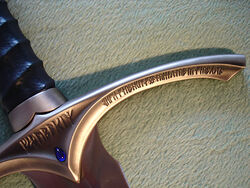Glamdring (also called the Foe-hammer and the Beater) was a hand-and-a-half sword, forged for Turgon, the Elven King of Gondolin during the First Age, and much later owned by the wizard Gandalf.
History
In the First Age, Turgon likely wielded it in the Nírnaeth Arnoediad and later, in the Fall of Gondolin. For over 6,000 years Glamdring went missing, being salvaged and surviving the War of Wrath, until Gandalf found it in a Troll cave in Eriador in TA 2941 (alongside Orcrist and what was later called 'Sting') and claimed it for himself.[3] With Glamdring Gandalf slew the Great Goblin shortly thereafter in Goblin-town, before he and Thorin II Oakenshield routed his underlings. Gandalf continued to use Glamdring through the events of the War of the Ring.
It was called "Beater" by the Orcs of the Misty Mountains.
Appearance

The Rune inscription on Glamdring in the films
Glamdring, along with Orcrist its mate, are described in The Hobbit as having "...beautiful scabbards and jeweled hilts", and Glamdring was referred to by Elrond as "Foe-hammer that the King of Gondolin once wore". In Unfinished Tales, one of the footnotes to the story "Of Tuor and his Coming to Gondolin" mentions that the sword of Turgon was "...white and gold...in a ruel-bone (ivory) sheath,..." While Glamdring is not mentioned by name, it is reasonable to assume that the same sword is described.
In common with other High-elven swords, Glamdring was like Orcrist and Sting in that "being the work of Elvish smiths in the Elder Days these swords shone with a cold light, if any Orcs were near at hand,"[4] and so it warned its bearers of nearby evil. Glamdring was "bright as blue flame for delight in the killing of the" Great Goblin,[5] but that could have referred to its brightness in that situation; everywhere else in J.R.R. Tolkien's writings, Glamdring's color when glowing is always described as white.
Etymology
The name Glamdring is Quenya for "Foe-hammer", from the Ñoldorin word dring ("beat, strike").[6]
In adaptations
Peter Jackson's film trilogies

Gandalf the White with Glamdring during the Battle of the Black Gate
In Peter Jackson's The Lord of the Rings and The Hobbit movie trilogies, Glamdring is one of Gandalf's primary weapons, the other being his staff. It has runes engraved in the Cirth script. Weta Workshop designer Richard Taylor stated that this was done with the intention that Elves put magic inscriptions on the blade to strengthen it. This idea is repeated with various other weapons, such as Andúril. In The Hobbit trilogy, Gandalf is able to recognise it as a sword of Gondolin, but Elrond identifies it by name. The design of the blade is also different to the Elvish curved swords regularly seen, likely because the blade was made in the First Age, where sword design was different.
While it does not glow in the films it is still powerful, especially in Gandalf's fight with the Balrog. It is strong enough to pierce the Balrog's flesh without damage, and is used by Gandalf to direct attacks of lightning, which enable him to vanquish the Balrog eventually.
Glamdring is inscribed with runes in the Elven language. In the movies, the runes say "Turgon Aran Gondolin, Tortha gar a matha Glamdring, Vegil Glamdring gud daelo. Dam an Glamhoth." which translates to "Turgon, King of Gondolin, wields, has, and holds the sword Glamdring, Foe of Morgoth's realm, Hammer of the Orcs."[7] This inscription, however, is not from J.R.R. Tolkien's writings. Tolkien only says in The Hobbit that the names of the swords were given in the runes. (A problem with this inscription is that it is in Sindarin, while Tolkien stated late in his life that Turgon had re-established Quenya as the language of his household in Gondolin (see The Peoples of Middle-earth, pg. 348).)
Reproductions
In addition to the licensed reproduction sword linked below, Del Tin Antiche of Italy made unlicensed interpretations of both Glamdring and Orcrist, which were sold through Museum Replicas, Ltd. back in the mid to late 1980's. These were very high quality steel and well-constructed (if quite plain).
United Cutlery currently manufactures an officially licensed replica of the movie prop. (UC2942)
Translations
| Foreign Language | Translated name |
| Arabic | غلامدرينغ |
| Armenian | Գլամդրինգ |
| Belarusian Cyrillic | Гламдрынг |
| Bengali | গ্লম্দ্রিন্গ |
| Bulgarian Cyrillic | Гламдринг |
| Czech | Vrahomlat |
| Chinese (Hong Kong) | 敵擊劍 |
| Chinese (Mandarin) | 格拉姆德凛 |
| Finnish | Vainovasara |
| Georgian | გლამდრინგი |
| Greek | Γκλάμντρινγκ |
| Gujarati | ગ઼લમ્દ્રિન્ગ |
| Hebrew | גלאמדרינג |
| Hindi | ङ्लम्द्रिङ |
| Japanese | グラムドリング |
| Kannada | ಘ್ಲಮ್ದ್ರಿಂಗ್ |
| Kazakh | Гламдрінг (Cyrillic) Glamdring (Latin) |
| Korean | 글람드링 |
| Kyrgyz Cyrillic | Гламдринг |
| Lithuanian | Glamdringas |
| Macedonian Cyrillic | Гламдринг |
| Marathi | घ्लम्द्रिङ्ग |
| Mongolian Cyrillic | Гламдринг |
| Nepalese | ग्लैमरडिंग |
| Pashto | علامدرینګ ? |
| Persian | گلامدرینگ |
| Punjabi | ਗ਼ਲਮ੍ਦ੍ਰਿਨ੍ਗ |
| Sanskrit | ङ्लम्द्रिङ् |
| Serbian | Гламдринг (Cyrillic) Glamdring (Latin) |
| Slovenian | Glamdring - Klina |
| Russian | Гламдринг |
| Tajik Cyrillic | Гламдринг |
| Telugu | గ్లామ్డ్రింగ్ |
| Thai | แกลมดริง |
| Ukrainian Cyrillic | Ґламдрінґ |
| Urdu | گلامڈرانگ |
| Uzbek | Гламдринг (Cyrillic) Glamdring (Latin) |
| Vietnamese | Đập tan Kẻ Thù |
| Yiddish | גלאַמדרינג |
| Barrow-blades • Sting | |
| Durin's Axe • Orcrist | |
| Grond (battering ram) • Grond (hammer) • Morgul-knife | |
| Aeglos • Anglachel • Anguirel • Angrist • Aranrúth • Belthronding • Dailir • Glamdring • Orcrist • Ringil | |
| Andúril • Dramborleg • Black arrow • Dagmor • Gúthwinë • Gurthang • Herugrim • Narsil • Red Arrow | |
References
- ↑ The Hobbit, Chapter III: "A Short Rest"
- ↑ The Hobbit, Chapter IV: "Over Hill and Under Hill"
- ↑ The Hobbit, Chapter III: "A Short Rest"
- ↑ The Lord of the Rings, The Fellowship of the Ring, Book Two, Chapter IV: "A Journey in the Dark"
- ↑ The Hobbit, Chapter IV: "Over Hill and Under Hill"
- ↑ The History of Middle-earth, Vol. V: The Lost Road and Other Writings, Part Three: "The Etymologies"
- ↑ The Lord of the Rings: Weapons and Warfare
